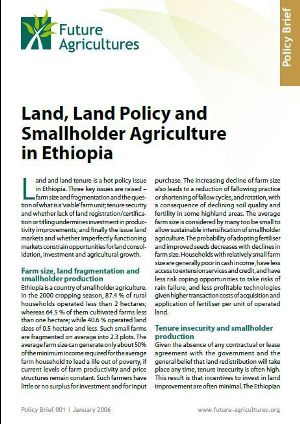By Samuel Gebreselassie
Policy Brief 001
 Land and land tenure is a hot policy issue in Ethiopia. Three key issues are raised – farm size and fragmentation and the question of what is a ‘viable’ farm unit; tenure security and whether lack of land registration/certi. Cation or titling undermines investment in productivity improvements; and finally the issue land markets andwhether imperfectly functioning markets constrain opportunities for land consolidation, investment and agricultural growth.
Land and land tenure is a hot policy issue in Ethiopia. Three key issues are raised – farm size and fragmentation and the question of what is a ‘viable’ farm unit; tenure security and whether lack of land registration/certi. Cation or titling undermines investment in productivity improvements; and finally the issue land markets andwhether imperfectly functioning markets constrain opportunities for land consolidation, investment and agricultural growth.
Farm size, land fragmentation andsmallholder production
Ethiopia is a country of smallholder agriculture. In the 2000 cropping season, 87.4 % of rural households operated less than 2 hectares; whereas 64.5 % of them cultivated farms less than one hectare; while 40.6 % operated land sizes of 0.5 hectare and less. Such small farms are fragmented on average into 2.3 plots. The average farm size can generate only about 50% of the minimum income required for the average farm household to lead a life out of poverty, if current levels of farm productivity and price structures remain constant. Such farmers have little or no surplus for investment and for input purchase.
The increasing decline of farm size also leads to a reduction of fallowing practice or shortening of fallow cycles, and rotation, with a consequence of declining soil quality and fertility in some highland areas. The average farm size is considered by many too be small to allow sustainable intensi. Cation of smallholder agriculture. The probability of adopting fertilizer and improved seeds decreases with declines in farm size. Households with relatively small farm size are generally poor in cash income, have less access to extension services and credit, and have less risk coping opportunities to take risks of rain failure, and less profitable technologies given higher transaction costs of acquisition and application of fertiliser per unit of operated land.
